Pharmacology > QUESTIONS and ANSWERS > Pharmacology ATI Exam | Highly Rated Exam | Download To Score An A+ (All)
Pharmacology ATI Exam | Highly Rated Exam | Download To Score An A+
Document Content and Description Below
Pharmacology ATI Exam Pharmacology ATI Exam Chapter 1: Pharmacokinetics and Routes of Administration • Absorption – how quickly or how well it is absorbed; DEPENDS ON THE ROUTE o Oral ... – takes a while, must pass through the GI tract Food can SLOW this down pH juices play a role Liquids vs extended release tablets o Sublingual – quick, under the tongue o Intradermal/topical – slow, gradual o Intravenous (IV) – the FASTEST route; immediate absorption • Distribution – requires binding proteins of medication o Albumin is a common binding protein • Metabolism – medication is inactivated o Occurs primarily in the LIVER o Factors that Influence Metabolism: Age – dysfunction of liver Children – metabolism is not mature yet o First-pass effect – medications are inactivated through their first pass of the liver; THEREFORE, you may need a HIGHER DOSE of the medication to reach therapeutic effects • Excretion – primarily done by the KIDNEYS • Therapeutic Index o HIGH TI = wide safety margin, no need for routine monitoring o LOW TI = small safety margin; NEEDS MONITORING; HIGH risk of toxicity Ex: vancomycin; need to draw peak/trough blood levels • Half-life – the amount of time it takes for the medication in the body to drop by 50% o Short half-life – leaves the body quickly o Long half-life – lingers in the body for long periods; HIGH risk of toxicity • Agonist – medication designed to produce an action • Antagonist – opposes the action • Nursing Considerations for Routes of Administration o Oral: May need to mix with apple sauce Want patient to sit up/Fowler’s position “Chin to chest” to help with swallowing REMEMBER! NEVER chew enteric-coated capsules REMEMBER! Never break/chew extended-release capsules o Sublingual/buccal: Keep medication in place until it is completely dissolved DO NOT eat/drink until it is completely dissolved o Transdermal: Wash and dry thoroughly Place patch on a hairless area Rotate patch sites o Eyes: Put into conjunctival sac Apply pressure to the nasolacrimal duct Wait 5 minutes between different drops Never touch the eye with the dropper (1-2 cm away) o Ears: Lay on unaffected side Pull up and out if they are an ADULT Pull down and back if they are a CHILD o NG/Nose: Flush before and after with 15 ml One last flush of 15 ml-30 ml o Suppository: Place just beyond the external sphincter Left lateral sims’ position o Inhalation: MDI (meter dose inhaler) • SHAKE 5-6 TIMES • TAKE DEEP BREATH 3-5 secs • HOLD BREATH 10 secs DPI (dry powder inhaler) • AVOID SHAKING INHALER • HOLD BREATH 10 secs o Intramuscular: REMEMBER! VASTUS LATERALIS for children under 2 years-old REMEMBER! DELTOID site MAX 1 mL of fluid REMEMBER! Z-TRACK prevents medication from walking back into subcutaneous tissue Chapter 2: Safe Medication Administration and Error Reduction • Routine/standard – regular schedule medication • One-time – only one dose • STAT – immediately • PRN – as needed • Medication reconciliation – comparing at home medications with hospital medications o Done UPON ADMISSION o Done UPON TRANSFER o Done AT DISCHARGE • REMEMBER! NEVER use trailing 0 • REMEMBER! ALWAYS use leading 0 • REMEMBER! NEVER administer a medication prepared by someone else • REMEMBER! NEED to fill out INCIDENT REPORT if given the WRONG MEDICATION o INCIDENT REPORTS DO NOT GO IN THE PATIENT’S CHART Chapter 4: Intravenous (IV) Therapy • Risks Associated with IV Therapy o Circulatory overload if the dose is too large or too rapid o Little time to correct errors o Failure to maintain surgical asepsis • DOs and DON’Ts o REMEMBER! NEVER put IV meds through tubing that is infusing blood or blood products o REMEMBER! NEVER infuse meds through tubing that is administering TPN o Verify compatibility of medications o Use a BP cuff instead of tourniquet; especially for OLDER ADULTS o Hold arm below the level of the heart o Try to stay away from back of hand o Want to change sites (usually every 72 hours) o REMEMBER! Fluids should NOT hand for more than 24 hours UNLESS it is a CLOSED BAG SYSTEM o Start distally 1st o Flush IV every 8-12 hours to keep patency o Monitor every hour at the least • Complications a. Infiltration – solution outside of the veins i. PALLOR, SWELLING, COLDNESS b. Extraversion – medication leaking outside of the veins i. PAIN, BURNING, REDNESS, SWELLING c. Hematoma – bruising at the site d. Catheter embolus (VERY SERIOUS SITUATION) – missing catheter tip after discontinuation e. Phlebitis – i. EDEMA, WARMTH, BURNING, PAIN f. Cellulitis – i. PAIN, WARMTH, EDEMA ii. SYSTEMIC SYMPTOMS: MALAISE, FEVER g. Fluid overload – i. DISTENDED NECK VEINS, HYPERTENSION, TACHYCARDIA, CRACKLES, DYSPNEA Chapter 6: Individual Considerations of Medication Administration • Factors Affecting Medication Dosages and Responses o Body weight – the bigger someone is, the higher the dose will need to be to get therapeutic effects o Age – Young children will need a smaller dose because their liver/kidneys are not fully developed, blood-brain barrier poorly developed, increased ability to absorb topical medications; older client’s liver/kidney function may be impaired o Gender – females have a higher proportion of body fat o Tolerance (IV DRUG USERS) o Accumulation – if someone has impaired kidney function, they may not be able to excrete it properly which could lead to toxicity o Psychological factors – someone’s frame of mind can impact effects o Medical problems – Diarrhea Inadequate gastric acids Liver disease Kidney disease • Pregnant o REMEMBER! MOST OF THE TIME it is NOT okay to take medications while pregnant o REMEMBER! Pregnant women should NOT have live vaccines (measles, mumps, rubella, polio) o REMEMBER! They should get the INACTIVATED INFLUENZA vaccine Chapter 7: Anxiety and Trauma-and Stressor-Related Disorders • Benzodiazepines (end in –am) o Diazepam o Lorazepam o Alprazolam o Chlrodiazepoxide Use: treatment of ANXIETY, seizures, muscle spasms, alcohol withdraw Action: increase the effects of GABA in your body SE: SEDATION, RESPIRATORY DEPRESSION, amnesia, dependency, withdraw Recommended for SHORT-TERM use NEVER just quit taking Antidote: FLUMAZENIL • Atypical anxiolytic (anti-anxiety) o Buspirone Use: ANXIETY, PANIC DISORDER, OCD, PTSD KEY POINTS: • CAN BE USED LONG TERM • SEDATION IS USUALLY NOT A PROBLEM • TAKES A FEW WEEKS FOR THERAPEUTIC EFFECTS TO APPEAR • DEPENDENCY RISK IS LOW SE: dizziness, nausea, headache (PAM HAS ANXIETY WENT ON A BENZO AND TAKES IT FOR A ONG TIME BUT REALIZES IT IS NOT HEALTHY SO SHE TAKES A BUS TO A PIER AND REALIZES SHE IS GOING TO BE HEALTHIER AND TAKE BUSPIRONE) • SSRI’s (end in –ine) o Paroextine o Sertaline o Fluoxetine Use: ANXIETY, DEPRESSION, OCD, PTSD Action: inhibit serotonin reuptake (increases the amount of serotonin in the body) (TEENS (-ines) CAN BE DIFFICULT AND CAUSE PARENTS TO HAVE ANXIETY AND DEPRESSION) SE: nausea, fatigue, WEIGHT GAIN, SEXUAL DYSFUNCTION WATCH FOR SERITONIN SYNDROME (TOO MUCH SERETONIN) SE: agitation, hallucinations, fever, tremors TAKES A FEW WEEKS FOR THERAPEUTIC EFFECTS TO APPEAR Chapter 8: Depressive Disorders • SSRI’s (end in –ine) o Paroextine o Sertaline o Fluoxetine Use: DEPRESSION Action: inhibit serotonin reuptake (increases the amount of serotonin in the body) SE: WEIGHT GAIN, SEXUAL DYSFUNCTION, nausea, fatigue WATCH FOR SERITONIN SYNDROME (TOO MUCH SERETONIN) SE: agitation, hallucinations, fever, tremors TAKES A FEW WEEKS FOR THERAPEUTIC EFFECTS TO APPEAR • Atypical Antidepressants o Buproprion o Trazadone (MAJOR SE IS SEDATION) Use: DEPRESSION, SMOKING CESSATION SE: insomnia, weight loss, GI distress, agitation, seizures, headache (B APPROPRIATE AND DON’T SMOKE OR YOU’LL GET DEPRESSION) • Tricyclic Antidepressants o Amitriptyline Use: DEPRESSION, NEUROPATHY, BIPOLAR DISORDER (AMI TRIPPED OVER A TRICYLE IN THE DESSERT) SE: ANTICHOLINERGIC (CAN’T PEE, CAN’T SEE, CAN’T SPIT, CAN’T SHIT) KEY POINTS: • IN ORDER TO COUNTERACT THESE SE’S CHEW GUM, WEAR SUNGLASSES, DRINK LOTS OF FLUIDS, HIGH FIBER DIET • MOST SERIOUS? Urinary retention • MAOI’s o Phenelzine Use: DEPRESSION THERE ARE A LOT OF DRUG INTERACTIONS SE: agitation, anxiety, orthostatic hypotension, HYPERTENSIVE CRISIS IF YOU EAT FOODS RICH IN TYRAMINE, YOU CAN TRIGGER THE HYPERTENSIVE CRISIS (I AM A PHENE FOR AGED CHEESES, BOLOGNA, WINE, AVACODO, SOY SAUCE, SALAMI, PEPPORONI, ETC BECAUSE OF MY DEPRESSION) Chapter 9: Bipolar Disorders • Mood stabilizer o Lithium carbonate Use: bipolar disorder SE: GI UPSET, FINE HAND TREMORS (COURSE HAND TREMORS ARE A SIGN OF TOXICITY), weight gain, renal toxicity NEED ADEQUATE FLUID INTAKE! IF LITIUM LEVELS ARE OVER 1.5 INDICATES TOXICITY STAY AWAY FROM DIURETICS AND ANTICHOLINERGIC MEDS AND NSAIDS • Antiepileptic drugs o Valproic acid (SE: HEPATOXICITY *) o Carbmazepine (SE: anemia, leukocytopenia, etc) Use: BIPOLAR DISORDER, anti-seizures Chapter 10: Psychotic Disorders • Antipsychotics (conventional) o Chlorpromazine o Haloperidol Use: psychotic disorders (schizophrenia, tourettes syndrome) SE: A BUNCH OF SIDE EFFECTS, EXTRAPYRAMIDAL SE’S, NEUROLEPTIC MALIGNANT SYDROME If the patient isn’t good about taking the medication, can get IM injections every 2 weeks • Antipsychotic (atypical) o Risperdone o Clozapine Use: schizophrenia SE: diabetes, weight gain, increased cholesterol, orthostatic hypotension If the patient isn’t good about taking the medication, can get IM injections every 2 weeks SHOULD AVOID ALCOHOL Chapter 11: Medications for Children and Adolescents with Mental Health Issues • CNS Stimulants o Methylphenidate o Amphetamine mixture (Adderall) Use: ADHD, conduct disorder SE: INSOMNIA, RESTLESSNESS, WEIGHT LOSS SHOULD NOT ADMINISTER AT NIGHT GIVE IMMEDIATELY BEFORE OR IMMEDIATELY AFTER A MEAL MONITOR THE CHILD’s WEIGHT Chapter 12: Substance Use Disorders • Alcohol withdraw – usually starts 4-12 hours after the last consumption of alcohol o SE: vomiting, tremors, increased BP, increased RR, increased HR WITHDRAW MEDICATIONS • Benzodiazepines (end in –am) • Adjunct medications to treat the high blood pressure (propranolol) ABSTINENCE MEDICATIONS • Disulfiram o IF THEY TAKE THIS, THEY WILL GET THE BAD SIDE EFFECTS • Naltrexone o SUPPRESSES THE CRAVING FOR ALCOHOL • Acamprosate o DECREASES THOSE ABSTINENCE SYMPTOMS OPIOD ADDICTION • Methadone substitution (THINK A METHADONE CLINIC) o Substitutes the use of opioids o GRADUALLY TAKE THEM OFF THIS MEDICATION NICOTINE ADDICTION • Buproprion o (B APPROPRIATE AND DON’T SMOKE) • Nicotine gum, nicotine patch • Varenicline (CHANTEX) o MONITOR FOR DEPRESSION Chapter 13: Chronic Neurologic Disorders • Myasthenia gravis – do not have enough acetacholine at receptor sites • Cholinesterase Inhibitors o Neostigmine o Physostigmine Use: treats myasthenia gravis SE: CHOLINERGIC EFFECTS o Edrophonium USED TO DIAGNOSIS MYASTHENIA GRAVIS o ATROPINE IS THE ATIDOTE • Anti-Parkinson’s Medications o Levadopa/carbidopa Use: Parkinson’s SE: nausea, vomiting, diarrhea, dyskinesia (grimacing, tics, tremors), orthostatic hypotension, darkening of urine and sweat, psychosis YOU WANT TO EAT CARBS, BUT LESS PROTEIN BC IT CAN DECREASE THE EFFECTIVENESS OF MED o Benzotropine Use: Parkinson’s SE: anticholinergic effects • Antiepileptics o Phenytoin Use: seizures SE: gingival hyperplasia (NEED TO CONSULT YOUR DENTIST) VERY CLOSELY MONITOR PLASMA LEVELS TO AVOID TOXICITY Decreased effectiveness of oral contraceptives Chapter 14: Eye and Ear Disorders • Beta-adrenergic blocker o Timolol (THESE ARE EYE DROPS) Use: decrease IOP in glaucoma • Carbonic anhydrase inhibitor o Acetazolamide Use: glaucoma SE: flu-like symptoms, GI effects, electrolyte imbalances Administer with food to prevent GI upset • Fluroquinolone Antibiotics plus steroid medications o Ciprofloxacin plus hydrocortisone Use: otitis externa (swimmer’s ear) Chapter 15: Miscellaneous Central Nervous System Medications • Neuromuscular blocking agents o Succinycholine o Pancuronium Use: anesthesia for muscle paralysis in surgery SE: MALIGNANT HYPERTHERMIA (muscle rigidity, fever), muscle pain Administer cooling measures if they have malignant hyperthermia Administer DANTROLENE • Muscle relaxants and antispasmodics o Dantrolene Use: malignant hyperthermia, muscle spasticity SE: drowsiness, muscle weakness, hepatotoxicity o Baclofen Use: muscle spasticity, malignant hyperthermia SE: drowsiness, constipation (IF YOU PULL OUT YOUR BACK, YOU MIGHT NEED BACLOFEN AS A MUSCLE RELAXER) • Muscarinic agonists o Bethanechol Use: treats urinary retention (BETH HAS A SHY BLADDER, SO THIS HELPS HER GO TO THE BATHROOM) SE: cholinergic effects Administer 1 hour before or 2 hours after meals • Muscarinic antagonists o Oxybutynin Use: overactive bladder, frequency, urgency, nocturia SE: anticholinergic effects Contraindicated: glaucoma Chapter 16: Sedative-Hypnotics • Nonbenzodiazepines o Zolpidem Use: insomnia SE: daytime sleepiness, dizziness Make sure patient has 8 hour dedicated sleep time • Intravenous anesthetics o Pentobarbital sodium o Propafal (CAN CAUSE PAIN AT THE IV SITE) o Medazolam Use: conscious sedation, intubation procedures SE: respiratory and cardiovascular depression, HIGH RISK FOR HYPOTENSION Chapter 17: Airflow Disorders • Beta2 Adrenergic Agonists o Albuterol Use: asthma, COPD SE: tachycardia, angina, tremors, jittery • Methylxanthines o Theophylline (IF YOU TAKE THEOPHYLLINE, YOU MIGHT BE SEEING GOD SOONER THAN YOU INTENDED) Use: asthma, COPD SE: BAD!!!!! GI upset, dysrhythmias, seizures VERY NARROW THERAPEUTIC RANGE WILL HAVE TO HAVE FREQUENT BLOOD DRAWS • Inhaled anticholinergics o Ipratropium Use: asthma, COPD SE: anticholinergic effects TELL PT TO INCREASE FLUIDS SUCK ON SUGAR FREE CANDY OR CHEW GUM TO RELIEVE THE DRY MOUTH • Glucocorticoids o Beclomethasone (BECKY HAS ASTHMA) Use: asthma, can be used alone or with the albuterol (DECREASES THE INFLAMMATION) SE: candidiasis ** NEED TO INFORM PT TO RINSE THEIR MOUTH OUT TO PREVENT THE FUNGAL INFECTION o Prednisone (VERY IMPORTANT DRUG! USED FOR A WIDE VARIETY OF THINGS; USED ALMOST ANY TIME YOU NEED TO REDUCE INFLAMMATION) o NEED TO KNOW ALL SIDE EFFECTS!!!!!!! Use: asthma, anything with inflammation, immune disorders SE: BONE LOSS, WEIGHT GAIN/FLUID RETENTION, HYPERGLYCEMIA, ADRENAL GLAND SUPPRESSION, MYOPATHY (MUSCLE WEAKNESS), PEPTIC ULCER DISEASE, INFECTION !!!!! NEED TO KNOW ALL NEVER SUDDENLY STOP TAKING! MUST TAPER OFF MONITOR FOR SIGNS AND SYMPTOMS OF INFECTION STAY AWAY FROM NSAIDS • Leukotrine modifiers o Montelukast Use: asthma, prevents exercise induced bronchospasm SHOULD INSTRUCT PT TO TAKE 2 HR BEFORE EXERCISE Chapter 18: Upper Respiratory Disorders • Antitussives: Opioids o Codeine (this could be cough syrup! There is a HIGH ABUSE rate) Use: FOR THAT DRY, NON-PRODUCTIVE COUGH SE: sedation, dizziness, constipation, respiratory depression INCREASE FIBER AND FLUID INTAKE • Expectorants o Guaifenesin (Mucinex) Use: for that PRODUCTVE COUGH, MUCUS FILLED SE: drowsiness, GI upset ACTION: reduces the viscosity of cough DRINK A LOT OF FLUIDS TO HELP LIQUIFY THOSE SECRETIONS • Mucolytics o Acetylcysteine Use: cystic fibrosis, ALSO USED AS AN ATIDOTE FOR ACETAMIDOPHEN POISIONING!!!!!!! Use in CAUTION with someone with asthma SE: dizziness, drowsiness, hypotension, tachycardia EXPECT THAT ROTTEN EGG SMELL!!!! • Decongestants o Phenylephrine o Pseudoephedrine Use: rhinitis (NASAL CONGESTION) SE: agitation, nervousness, palpitations IF YOU TAKE IT A LONG TIME AND GO OFF OF IT, YOU WILL GET THAT REBOUND CONGESTION • Antihistamines o Diphenhydramine (Benadryl) o Loratadine Use: nasal congestion, mild allergic reactions, motion sickness SE: anticholinergic, constipation, urinary retention, SEDATION • Nasal glucocorticoids o Mometasone Use: rhinitis, nasal itching, runny nose (MOM HAS A STUFFY NOSE!) Chapter 19: Medications Affecting Urinary Output • Loop diuretics o Furosemide (Lasix) Use: fluid retention caused by heart failure SE: HYPOTENSION, HYPONATREMIA, HYPOKALEMIA, OTOTOXICITY, DEHYDRATION (VERY IMPORTANT!) TAKE IT IN THE AM, NOT THE MORNING SO THEY WONT BE WAKING UP TO PEE!!!!! MONITOR ELECTROLYTE LEVELS EAT FOODS HIGH IN POTASSIUM WEIGH PATIENT DAILY!!!!! • Thiazide diuretics o Hydrochlorothiazide Use: fluid retention caused by heart failure, used in hypertension SE: dehydration, hypokalemia, hyperglycemia • Potassium sparing diuretics o Spironolactone Use: fluid retention caused by heart failure SE: HYPERKALEMIA, AMMENORRHEA, GYNOCYMASTIA NOT ELIMINATING THE POTASSIUM Contraindications: kidney disease • Osmotic diuretics o Mannitol Use: prevents kidney failure, DECREASES INTRACRANIAL PRESSURE (MAN I HAD THE WORST HEADACHE FROM ALL THE INTRACRANIAL PRESSURE BUT MAN IT WENT AWAY WHEN I TOOK MANNITOL) SE: heart failure, pulmonary edema, rebound increased intracranial pressure Chapter 20: Medications Affecting Blood Pressure • ACE Inhibitors (ALL END IN –pril) o Captopril o Lisinopril Use: hypertension, heart failure, MI’s SE: COUGH, HYPERKALEMIA, ANGIOEDEMA (A-ANGIOEDEMA, C-COUGH, E-ELEVATED POSTASSIUM! HYPERKALEMIA), hypotension Want patient to change position slowly bc of orthostatic hypotension Want patient to monitor their BP • Angiotensin 2 receptor Inhibitors (ALL END IN –sartan) o Lorsartan Use: hypertension, heart failure, MI’s SE: ANGIOEDEMA, GI UPSET, HYPOTENSION • Calcium Channel blockers (END IN –ipine) o Nifedipine o Amlodipine o Verapamil o Diltiazem Use: angina, hypertension, cardiac dysrhythmias SE: hypotension, slow HR, peripheral edema, constipation SHOULD NOT DRINK GRAPE JUICE SHOULD MONITOR HR AND BLOOD PRESSURE • Beta blockers (END in –lol) o Metoprolol o Propranolol o Atenolol Use: hypertension, angina, tachycardia, heart failure, MI’s SE: BRADYCARDIA, ORTHOSTATIC HYPOTENSION, HYPOTENSION, FATIGUE, ERECTILE DYSFUNCTION (STAY AWAY FROM ED DRUGS) BRONCHOCONTRICTION IS A BIG SE IN PROPANOLOL!!!! DO NOT LET PEOPLE WITH ASTHMA TAKE THIS!!!!!!!!! IMPORTANT • Medications for hypertensive crisis (Nitro) o Nitroprusside Use: hypertensive crisis, MI’s SE: HYPOTENSION, CYANIDE POISONING Chapter 21: Cardiac Glycosides and Heart Failure • Cardiac glycosides o Digoxin (SUPER IMPORTANT!!!!!!) Use: HEART FAILURE, V-FIB (MOM, DID YA GET UR PRECRIPTION FOR HEART FAILURE? YEAH I GOT MY DIGOXIN) SE: DSYRHYTHMIAS, BRADYCARDIA KNOW THE SIGNS OF DIGOXIN TOXICITY! GI UPSET, FATIGUE, VISION CHANGES! WITHHOLD IF YOU HAVE A HR UNDER 60 ALWAYS CHECK THE PULSE RATE FOR THE FULL MINUTE BEFORE GIVING MONITOR DIGIXIN LEVELS 0.5-2 (OVER 2 IS TOXIC) KEEP POTASSIUM LEVELS UP! INCREASE THE POTASSIUM RICH FOOD TREAT OVERDOSE WITH DIGIBINE/DIGOXIN IMMUNE FAB/ACTIVATED CHARCOAL • Adrenergic agonists o Epinephrine o Dopamine Use: cardiac arrest, asthma SE: hypertensive crisis, dysrhythmias Chapter 22: Angina • Nitrates o Nitroglycerin Use: angina attack SE: HEADACHE!!!!!!! (VERY COMMON), ORTHOSTATIC HYPOTENSION, REFLEX TACHYCARDIA Sublingual: IF YOU ARE HAVING CHEST PAIN, SIT DOWN, ADMINISTER NITROGLYCERIN, WAIT 5 MINUTES, IF IT IS NOT GONE THEN CALL 911, ADMINISTER ANOTHER TABLET, WAIT 5 MINUTES, TAKE ANOTHER IF IT HASN’T SUBSIDED Patch/Transdermal: PLACE ON A HAIRLESS SPOT, ROTATE SITES, REMOVE OLD PATCH, WEAR GLOVES Chapter 24: Antilipemic Agents (Cholesterol Medications) • HMG-CoA Reductase Inhibitors (END IN –statin) o Atorvastatin o Simvastatin Use: used to lower cholesterol, decreases LDL SE: HEPATOTOXICITY, MYOPATHY (muscle pain) ADMINISTER IN THE EVENING WITH A MEAL!!!!!! CHOLESTEROL IS SYNTHESIZED AT NIGHT MONITOR LIVER FUNCTION AVOID ALCOHOL • Bile-acid sequestrants o Colesevelam o Colestipol Use: used to lower cholesterol levels, decreases LDL SE: CONSTIPATION INCREASE FIBER AND FLUID INTAKE INTERFERES WITH FAT-SOLUBLE VITAMIN ABSORPTION • Nicotinic acid, niacin o Niacin Use: used to lower cholesterol, decreases LDL and RAISE HDL SE: FLUSHING OF THE FACE, HYPERGLYCEMIA, HEPATOXICITY, GI DISTRESS MONITOR LIVER FUNCTION MONITOR BLOOD GLUCOSE LEVELS • Fibrates o Gemfibrozil o Fenofibrate Use: reduces triglycerides, increases HDL SE: GI DISTRESS, GALLSTONES, MYOPATHY (MUSCLE PAIN), HEPATOXICITY GIVE MEDICATION 30 MINS BEFORE BREAKFAST AND DINNER Chapter 25: Medications Affecting Coagulation • Anticoagulant o Heparin o Enoxaparin (LOW MOLECULAR WEIGHT HEPARIN) Use: PREVENTS NEW CLOTS!!!!! (DOES NOT BREAK UP EXISTING CLOTS) SE: bleeding, heparin-induced thrombocytopenia WHEN A PATIENT IS ON HEPARIN, WE MONITOR THE aPTT LEVELS ANTIDOTE: PROTAMINE LOOK FOR SIGNS OF BLEEDING! Black tarry stools, coffee ground emesis • Oral anticoagulants o Warfarin Use: PREVENTS CLOTS!!!!! SE: BLEEDING, GI upset, hepatitis MONITOR PT and INR LEVELS • 2-3 therapeutic INR levels ANTIDOTE: VITAMIN K DON’T INCREASE YOUR INGESTION OF VITAMIN K FOODS! LEAFY GREENS • Antiplatelets o Aspirin o Abciximab o Clopidogrel Use: PREVENTS PLATELETS FROM CLUMPING SE: GI upset, BLEEDING, TINNITUS DO NOT GIVE ASPIRIN TO CHILDREN! REYES SYNDROME CONTRAINDICATED IN PEOPLE WITH BLEEDING DISORDERS • Thrombolytics (END IN –plase) (IF YOU HAVE COME TO BREAK UP A CLOT, YOU’VE COME TO THE RIGHT PLACE) o Alteplase Use: BREAKS UP CLOTS SE: BLEEDING!!!!!! CONTRAINDICATED IN PEOPLE WITH A HEMORRHAGIC STROKE, SEVERE HYPERTENSION, SURGERY Closely monitor labs and vital signs Stay away from vein punctures Chapter 26: Growth Factors • Erythropoietic growth factors o Epoetin alpha Use: anemia, increases those RBCs SE: HYPERTENSION DO NOT AGITATE THE VIAL MONITOR BP Ensure they have sufficient iron levels • Leukopoietic growth factors o Filgrastim Use: NEUTROPENIA SE: BONE PAIN, LEUKOCYTOSIS (TOO MANY WBCS), spleen rupture MONITOR CBC LEVELS TWICE A WEEK DO NOT AGITATE THE VIAL Chapter 27: Blood and Blood Products • Get baseline vitals before giving blood • Get the patient to sign consent • Get the vitals before beginning the transfusion • 20-guage or bigger IV catheter • 0.9% sodium chloride NORMAL SALINE ONLY • ALWAYS have 2 nurses to CONFIRM blood • CAN ONLY HANG 4 HOURS ADVERSE REACTIONS TO BLOOD: • STOP THE TRANSFUSION • DISCONNECT THE TUBING • HOOK TO NORMAL SALINE • CALL THE PROVIDER • Obtain a urine specimen to determine RBC hemolysis SYMPTOMS: • Fever • Low back pain • Anaphylaxis • Sepsis • Tachycardia • Dyspnea • Hypertension Chapter 28: Peptic Ulcer Disease • Histamine-receptor antagonists (END IN –tidine) o Ranitidine o Climetidine Use: peptic ulcer disease, GERD SE: increases the risk or bacteria DO NOT OVEREAT REDUCE STRESS LEVEL AVOID NSAIDS • Proton pump inhibitors (END IN –prazole) o Omeprazole o Pantoprazole Use: peptic ulcer disease, GERD SE: GI UPSET, OSTEOPOROSIS • Muscosal protectant (PROTECTIVE LINING OVER THE ULCERS) o Sucralfate Use: stomach ulcers SE: CONSTIPATION!!!!!!!!!!!!! Take 1 hour before meals and at bedtime!!!!!! INCREASE FIBER AND FLUID INTAKE • Antacids o Magnesium hydroxide (SE: DIARRHEA) o Aluminum hydroxide (SE: CONSTIPATION) o Calcium carbonate (SE: CONSTIPATION) Use: peptic ulcer disease DO NOT TAKE WITH OTHER MEDICATIONS • Prostaglandins o Misoprostol Use: clients on LONG-TERM NSAIDS to prevent gastric ulcers CANNOT!!!!! USE!!!!!! IN!!!! PREGNANT WOMEN!!!!!!!!!!! Must obtain a pregnancy test before giving this!!!!!!! Chapter 29: Gastrointestinal Disorders • Laxatives o Psyllium o Docustate sodium o Bisacodyl o Magnesium hydroxide Use: SOFTEN STOOL SE: GI upset, rectal burning sensation, toxic magnesium levels CANNOT BE USED IF THEY HAVE A BOWEL OBSTRUCTION INCREASE EXERCISE • Antidiarrheals o Loparamide o Diphenoxylate plus atropine Use: stop diarrhea SE: constipation, drowsiness, anticholinergic effects • Prokinetic agents o Metoclopramide Use: nausea, vomiting SE: EXTRAPYRAMIDAL EFFECTS (restlessness, anxiety, dyskinesia, tremors, rigity), sedation, diarrhea Chapter 30: Vitamins, Minerals, and Supplements • Iron preparations o Ferrous sulfate Use: iron deficiency SE: GI UPSET, TEETH STAINING, STOOLS WILL BE DARK GREEN/BLACK VITAMIN C INCREASES ABSORPTION OF IRON INCREASE FLUID AND FIBER TO PREVENT CONSTIPATION Increase intake of iron rich foods • Vitamin B12 o Vitamin B12 Use: metablastic anemia • Folic Acids o Folic acid Use: pregnant women for neural tubes for fetus, alcohol use disorder NEVER GIVE FOLIC ACID TO SOMEONE LACKING B12 • Potassium o Potassium Use: hypokalemia, use of diuretics SE: hyperkalemia NEVER GIVE A RAPID INFUSION OF POTASSIUM • Magnesium o Magnesium Use: hypomagnesima, preterm labor • Herbal Supplements o Black cohash Use: menopause o Garlic, ginger, ginko biloba CAN INCREASE BLEEDING!!!!! o St. John’s Wart Use: mild depression o Valerian Use: anxiety Chapter 31: Medications Affecting the Reproductive Tract • Estrogens o Conjugated equine estrogens o Estradiol Use: birth control, menopause SE: thrombolytic events, weight gain, edema, CONTRAINDICATED IN THESE PATIENTS: SMOKERS!!!!! HYPERTENSION!!!! PATIENTS AT HIGH RISK FOR EMBOLIC EVENTS!!!!!!!! • Progesterone o Medroxyprogesterone Use: birth control, maintain pregnancy SE: thrombolytic events, break-through bleeding, breast cancer PATIENTS SHOULD DELAY CONCEPTION FOR 3 MONTHS CONTRAINDICATED IN PATIENTS WHO ARE AT RISK FOR EMBOLIC EVENTS!!!!!!!!! • Androgens o Testosterone Use: hypogonadism, delayed puberty in boys, post-menopausal breast cancer SE: acne, EPIPHYSEAL CLOSURE HIGH ABUSE POTENTIAL CONTRAINDICATED IN PEOPLE WITH PROSTATE CANCER • 5-Alpha reductase inhibitors o Finasteride Use: BPH, male pattern baldness SE: ED, gynecomastia PREGNANT WOMEN SHOULD NEVER HANDLE THIS MEDICATION!!!!!!!! • Alpa1-adrenergic antagonists o Tamsulosin Use: BPH SE: hypotension, nasal congestion, sleepiness, faintness HOLD THE MEDICATION BEFORE CATARACTS SURGERY!!!! FLOPPY IRIS SYNDROME • Phosphodiesterase type 5 inhibitors o Sildenafil Use: erectile dysfunction SE: HYPOTENSION!!!! Priapism, INCREASED RISK OF MI!!!!! SHOULD NOT TAKE WITH ANY OTHER NITRATES!!!!!!!!!!!!!! KNOW THIS!!!!!!!!!!!!!!!!!!!!!!! ISOBORBIDE!!!!!!!! NITROGLYCERIN!!!!! Chapter 32: Medications Affecting Labor and Delivery • Uterine stimulants o Oxytocin Use: INDUCES LABOR SE: painful contractions, uterine rupture CLOSELY MONITOR CONTRACTIONS LESS THAN 60 SECONDS, 2-3 MINUTES APART!!!! If it is more, DISCONTINUE and notify provider Monitor mother and fetus • Tocolytic medications o Terbutaline Use: prevent preterm labor SE: tachycardia, angina Contraindicated: GESTATION OF 34 WEEKS OR GREATER, or DIALATION of 6 cm or greater • Opioid analgesics o Fentanyl Use: pain of birth SE: dry mouth, tachycardia, sedation, nausea, vomiting DELIVERY MUST BE WITHIN 1-4 HOURS NOW Chapter 33: Connective Tissue Disorders o Methotrexate Use: rheumatoid arthritis SE: INFECTION!!!! Because of that immunosuppression, hepatotoxicity, bone marrow suppression o Cyclosporine Use: rheumatoid arthritis SE: infection!!!! Hepatotoxicity, nephrotoxicity Chapter 34: Bone Disorders • Calcium supplements o Calcium citrate Use: hypocalcemia, pregnant women/breastfeeding SE: hypercalcemia NEED ADEQUATE VITAMIN D FOR ABSORPTION • Selective estrogen receptor modulator o Raloxifene Use: osteoporosis (I CAN RELAX NOW THAT I AM TAKING RALOXIFENE FOR MY OSTEOPOROSIS) SE: DVT, hot flashes ENCOURAGE PATIENT TO INCREASE IN CALCIUM ENCOURAGE WEIGHT BARING EXERCISE • Bisphosphonates (END IN –dronate) o Aldendronate Use: OSTEOPOROSIS SE: ESOPHAGITIS!!!!!!!!!! WANT PATIENT TO SIT UP FOR 30 MINUTES WHILE TAKING TO PREVENT ESOPHAGITIS!!!!!!!!!! TAKE IN AM DRINK 8 oz OF WATER • Calcitonin o Calcitonin salmon Use: osteoporosis SE: gi upset, nasal irritation, dryness Chapter 35: Nonopioid Analgesics • NSAIDS o Aspirin (TINNITUS) o Ibuprofen o Naproxen Use: pain relief SE: GI UPSET, GI BLEEDING, STAY AWAY IF THEY ARE BABIES BC OF REYES SYNDROME!!!! • Acetaminophen o Use: pain relief o SE: HEPATOTOXICITY!!!!!! o MAX OF 4 G PER DAY!!!!!!!!!!!!!!! NO MORE o ACETYLCYSTINE is ANTIDOTE Chapter 36: Opioid Agonists and Antagonists • Opioid agonists o Morphine o Fentanyl o Codeine Use: pain relief SE: RESPIRATORY DEPRESSION!!!! SEDATION!! CONSTIPATION!!! GI UPSET, URINARY RETENTION, HYPOTENSION Naloxone is ANTIDOTE MONITOR RESPIRATORY STATUS, BP MONITOR AROUND THE CLOCK FOR CANCER PAIN INCREASE FIBER AND FLUID INTAKE • Opioid Antagonist o Naloxone Use: antidote for opioid SE: HYPERTENSION, ANGINA, AGITATION, TACYCARDIA, TACYAPNEA, GI UPSET BETTER BE READY FOR THEM TO COME UP SWINGING MONITOR THEIR PAIN Chapter 38: Miscellaneous Pain Medications • Migraine Medications o Ergotamine Use: acute attacks of migraine headache SE: Hypertension, GI upset, muscle pain, numbness, tingling SHOULD LAY DOWN IN A DARK QUIET PLACE AVOID TYRAMINE RICH FOODS AVOID ALCOHOL ONLY TAKE WHEN YOU ARE EXPERIENCING A HEADACHE! Taking prophylactically can lead to dependence o Sumatriptan Use: acute attacks of migraines SE: Angina, dizziness, warm-tingling sensation SHOULD LAY DOWN IN A DARK QUIET PLACE AVOID TYRAMINE RICH FOODS AVOID ALCOHOL • Local anesthetics o Lidocaine Use: pain management for dental procedures, surgical procedures, labor and delivery SE: Hypotension, bradycardia, prolonged labor, allergic reactions, spinal headache, SEIZURES CAN BE USED FOR TOPICAL ADMINISTRATION (pain at an IV injection site) WANT TO APPLY THE LIDOCAINE 1 HOUR BEFORE THE PROCEDURE, then cover with an occlusive dressing Chapter 39: Diabetes Mellitus REMEMBER: CLOUDY (intermediate-acting; NPH) to CLEAR (short-acting; R), then CLEAR (short-acting; R) TO CLOUDY (intermediate-acting; NPH) • Insulins o regular insulin (Humulin R) – SHORT-ACTING ONSET: 0.5 to 1 hour PEAK: 1 to 5 hour DURATION: 6 to 10 hour INSULIN OF CHOICE IN ACUTE SITUATIONS (SUCH AS DKA, severe infection, and surgical procedures) Use: lower blood glucose, but the dose must be individualized according to blood glucose levels SE: HYPOGLYCEMIA, tachycardia, sweating, shaking, headache Contraindications: hypoglycemia because of risk of brain damage ONLY insulin that can be given intravenously (IV) Approved for use in external insulin pumps o isophane insulin (NPH insulin) – INTERMEDIATE-ACTING ONSET: 1 to 2 hour PEAK: 6 to 14 hour DURATION: 16 to 24 hour Use: lower blood glucose, but the dose must be individualized according to blood glucose levels SE: HYPOGLYCEMIA, tachycardia, sweating, shaking, headache Often used for long-term therapy; for most patients, given in combination with a short-acting insulin Provides a more consistent regulation of blood glucose levels CLOUDY SOLUTION; REMEMBER: roll in hands before administering, DO NOT shake o linspro insulin OR glulisine insulin OR aspart insulin – RAPID-ACTING (FASTEST ACTING) ONSET: 15 to 30 minute PEAK: 0.5 to 2.5 hour DURATION: 3 to 6 hour Use: lower blood glucose, but the dose must be individualized according to blood glucose levels SE: HYPOGLYCEMIA, tachycardia, sweating, shaking, headache MAKE SURE THEIR FOOD IS RIGHT IS FRONT OF THEM o glargine insulin (Lantis) OR detemir insulin (Levamir) – LONG-ACTING ONSET: 70 minute PEAK: NONE DURATION: 24 hour Use: lower blood glucose, but the dose must be individualized according to blood glucose levels SE: HYPOGLYCEMIA, tachycardia, sweating, shaking, headache REMEMBER: CANNOT EVER mix Lantis or Levamir with ANY OTHER INSULIN REMEMBER: CANNOT be used in external insulin pump (AKA a subcutaneous pump) • Sulfonylureas o Glyburide o Glipizide Use: type 2 diabetes SE: HYPOGLYCEMIA, photosensitivity, GI upset Take this medication 30 minutes before a meal Patient should wear sunscreen because of the photosensitivity • Meglitinides o Repaglinide Use: type 2 diabetes SE: HYPOGLYCEMIA, angina Take 3 times a day, eat within 30 minutes of the dose • Biguinides o Metformin Use: type 2 diabetes SE: GI upset, B12 deficiency, metallic taste, LACTIC ACIDOSIS Take this with a meal DO NOT drink alcohol Will probably have to DISCONTINUE dose if they have an upcoming procedure or anything with contrasting dye • Alpha glucoside inhibitors o Acarbose Use: type 2 diabetes SE: GI upset, hepatotoxicity, anemia Taken with the 1st bite of food • Glucagon o Glucagon Use: SEVERE HYPOGLYCEMIA, insulin overdose Provide IM or IV Provide food as soon as the patient is able to safely swallow SE: GI upset Chapter 40: Endocrine Disorders • Thyroid hormone o Levothyroxine Use: HYPOTHYROIDISM SE: GI upset, anxiety, heat intolerance, weight loss (HYPERTHYROID) Take in the morning with a full glass of water LIFE-LONG TREATMENT • Antithyroid hormone o Propylthiouracil Use: HYPERTHYROIDISM, preparation for a thyroidectomy SE: lethargy, weight gain, depression (HYPOTHYROID) Monitor the liver function o Radioactive iodine Use: HYPERTHYROIDISM SE: radiation sickness, bone marrow suppression, HYPOTHYROID o Strong iodine solution Use: HYPERTHYROIDISM SE: Iodism (metallic taste, stomatitis, sore teeth and gums, frontal headache, skin rash), hypersensitivity Increase fluid intake Can mix the solution to improve taste Avoid food high in iodine (salt/seafood) • Anterior pituitary hormones/growth hormones o Somatropin Use: stimulates growth SE: hyperglycemia Administer via IM or SUBQ STOP TREATMENT PRIOR TO EPIPHYSEAL CLOSURE!!!!!! MONITOR BRONE GROWTH!!!!!!!! • Antidiuretic hormone o Vasopressin o Desmopressin Use: DIABETES INSIPIDUS (EXCESSIVE THIRST! EXCESSIVE URINATION) SE: headache Reduce their fluid intake during therapy • Adrenal hormone replacement o Hydrocortisone Use: Addison’s disease SE: OSTEOPOROSIS, PEPTIC ULCERS, INFECTION, WEIGHT GAIN ALWAYS TAPER OFF!!!! May increase dose in signs of stress Chapter 42: Chemotherapy Agents • Antitumor antibiotics o Doxorubicin Use: treating solid tumors SE: GI upset, alopecia, bone marrow suppression, cardiac toxicity, RED DISCOLORATION OF URINE, SWEAT, TEARS (The BALD DOCEN is SICK because of his TUMOR and he is crying RED TEARS) • Antimitotics o Vincristine Use: tumors and cancer DOES NOT CAUSE BONE MARROW SUPPRESSION SE: phlebitis at the IV site, peripheral neuropathy (weakness, parathesia), severe tissue damage, GI upset, alopecia (If you drink too much Vino you will get cancer and won’t be able to feel your arms and legs) • Alkylating agents o Cyclophosphamide Use: tumors and cancer SE: bone marrow suppression, GI upset, alopecia, ACUTE HEMORRHAGIC CYSTITIS Increase fluid LOOK for BLOOD IN URINE ADMINISTER Uroprotectant agent!!!! MESNA (Cy wants to go CYCLING but she is afraid her cancer will make her have CYSTITIS and she will PEE BLOOD) • Noncytotoxic chemotherapy agents o Leuprolide Use: PROSTATE CANCER SE: hot flashes, gynecomastia, decreased libido, decreased bone density (Leuprolide makes your libido leuk-warm because of the nasty side effects; gynecomastia and hot flashes! LIKE A WOMAN) o Tamoxifen Use: BREAST CANCER SE: hot flashes, GI upset, hypercalcemia, INCREASED RISK OF ENDOMETRIAL CANCER • Biologic response modifiers o Interferon alfa-2b Use: cancers and viral infections SE: FLU-LIKE symptoms, bone marrow suppression, cardiac suppression, GI upset, alopecia, NEUROPATHY, DEPRESSION, MUSCLE ACHES (Interferon INTERFERES with CANCER BUT gives you flu-like symptoms) Chapter 43: Principles of Antimicrobial Therapy • ALWAYS do a CULTURE before starting any antibiotics • NEED TO FINISH the ENTIRE course of antibiotic therapy Chapter 44: Antibiotics Affecting the Bacterial Cell Wall • Penicillins (END in –cillin) o Penicillin-G o Amoxicillin Use: strep, meningitis, endocartitis, any bacterial infection SE: POSSIBLE ALLERGIC REACTION! GI upset, renal toxicity CHECK to see if they have any reaction to penicillins or cephalosporins • Cephalosporins (BEGIN with –ceph/cef) o Cephalexin o Cefazolin o Ceftriaxone Use: any bacterial infection SE: GI upset, ALLERGIC REACTION, bleeding, SUPERINFECTION!!!! (C. diff or yeast infection; superinfection) CHECK to see if they have any reaction to penicillins or cephalosporins • Carbapenems o Imipenem-cilastatin Use: serious bacterial infections SE: GI upset, rash, SUPERINFECTION • Other inhibitors of cell wall synthesis o Vancomycin Use: serious infection, C. DIFF infections SE: OTOTOXICITY, RENAL TOXICITY!!!!!!! *** MONITOR TROUGH LEVELS!!!!!!!!!!!!!!!!!!! Dose may need to be adjusted based on creatinine levels (Someone is in a VAN and THEY TURN THE MUSIC UP TOO LOUD and they give themselves OTOTOXICITY) Chapter 45: Antibiotics Affecting Protein Synthesis • Tetracyclines (END in –cycline) o Tetracycline o Doxycycline Use: bacterial infections, lyme disease, rocky mountain spotted fever SE: GI upset, TOOTH DISCOLORATION, hepatotoxicity, photosensitivity, dizziness NEVER GIVE TO PREGNANT WOMEN OR KIDS UNDER 2 YEARS OLD!!!!!!! Use another method of BC Take with a full glass of water DAIRY PRODUCTS CAN DECREASE ABSORPTION!!!!!!! • Macrolides (END in –mycin) o Erythromycin Use: bacterial infection SE: GI upset, OTOTOXICITY, PROLONGED QT intervals • Aminoglycosides (END in –mycin) o Gentamicin Use: SERIOUS bacterial infections SE: OTOTOXICITY, NEPROTOXICITY, VERTIGO, ATAXIA Monitor for tinnitus and hearing loss DRAW THE PEAK AND TROUGH!!!!!!!!!!!!!!!! Chapter 46: Urinary Tract Infections • Sulfonamides o Trimethoprim-sulfamethoxazole Use: UTI’s SE: GI upset, blood dyscrasias, crystalluria, kernicterus, hyperkalemia, hypersenisitivity INCREASE FLUID INTAKE TO PREVENT CRYSTALLURIA • Urinary tract antiseptic o Nitrofurantoin Use: UTI SE: GI upset, hypersensitivity, blood dyscrasias, brown urine, peripheral neuropathy • Fluoroquinolones (END in –floxacin) o Ciprofloxacin o Oflaxacin o Levofloxacin Use: UTI SE: GI upset, photosensitivity, SUPERINFECTION, ACHILLES TENDON RUPTURE • Urinary tract analgesic o Phenazopyridine (AZO) Use: UTI SYMPTOMS, PAIN, URGENCY SE: ORANGE-RED URINE!!!!!!!!!! Chapter 47: Tuberculosis Medications • USUALLY ON THESE FOR 6-12 MONTHS • Antituberculosis o Isoniazid (SE: Neuropathy!!!!) o Rifapentine (SE: ORANGE-COLORED SECRETIONS) o Pyrazinamide o Ethambutol (SE: CHANGES IN VISION) Use: tuberculosis SE: HEPATOTOXICITY!!!!!!!!!!!!!!! Patient needs 3 negative sputum samples to be considered free of TB Patient will have to wear an N95 mask No alcohol for the full treatment • Antiprotazoal o Metronidazole Use: TB, protazoans SE: GI upset, METALLIC TASTE!, DARK URINE!, dizziness, headache PATIENT SHOULD NOT DRINK ALCOHOL (someone’s car broke down and she’s taking the METRO and she has this METALLIC TATSE in her mouth and when she uses the restroom her pee is DARK! Now she is like “oh great and I can’t even have a drink after this) • Antifungals o Amphoteracin B o Ketoconazole Use: fungal infections SE: HEPATOTOXICITY, GI USPET, BONE MARROW SUPPRESSION, NEPROTOXICITY, PHELBITIS DO a TEST DOSE 1st Chapter 48: Viral Infections, HIV, and AIDs Antivirals (END in –vir) o Acyclovir o Ganciclovir Use: VIRUSES, HERPES, VARICELLA SE: phlebitis, GI upset, nephrotoxicity, gingival hyperplasia THESE MEDS DO NOT CURE CONDITIONS! THEY SUPPRESS THE VIRUS [Show More]
Last updated: 2 years ago
Preview 1 out of 27 pages

Buy this document to get the full access instantly
Instant Download Access after purchase
Buy NowInstant download
We Accept:

Reviews( 0 )
$18.50
Can't find what you want? Try our AI powered Search
Document information
Connected school, study & course
About the document
Uploaded On
Feb 20, 2021
Number of pages
27
Written in
Additional information
This document has been written for:
Uploaded
Feb 20, 2021
Downloads
0
Views
110

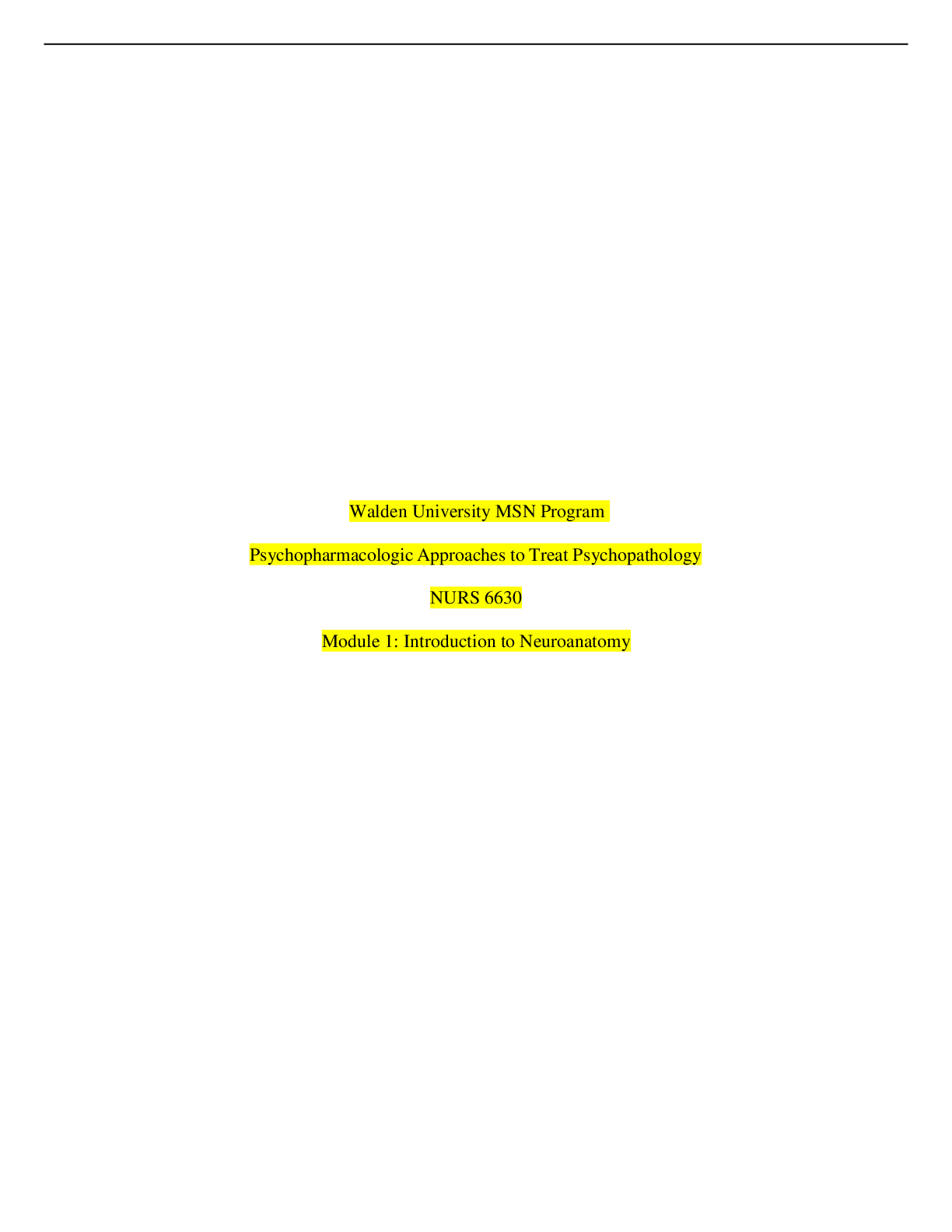


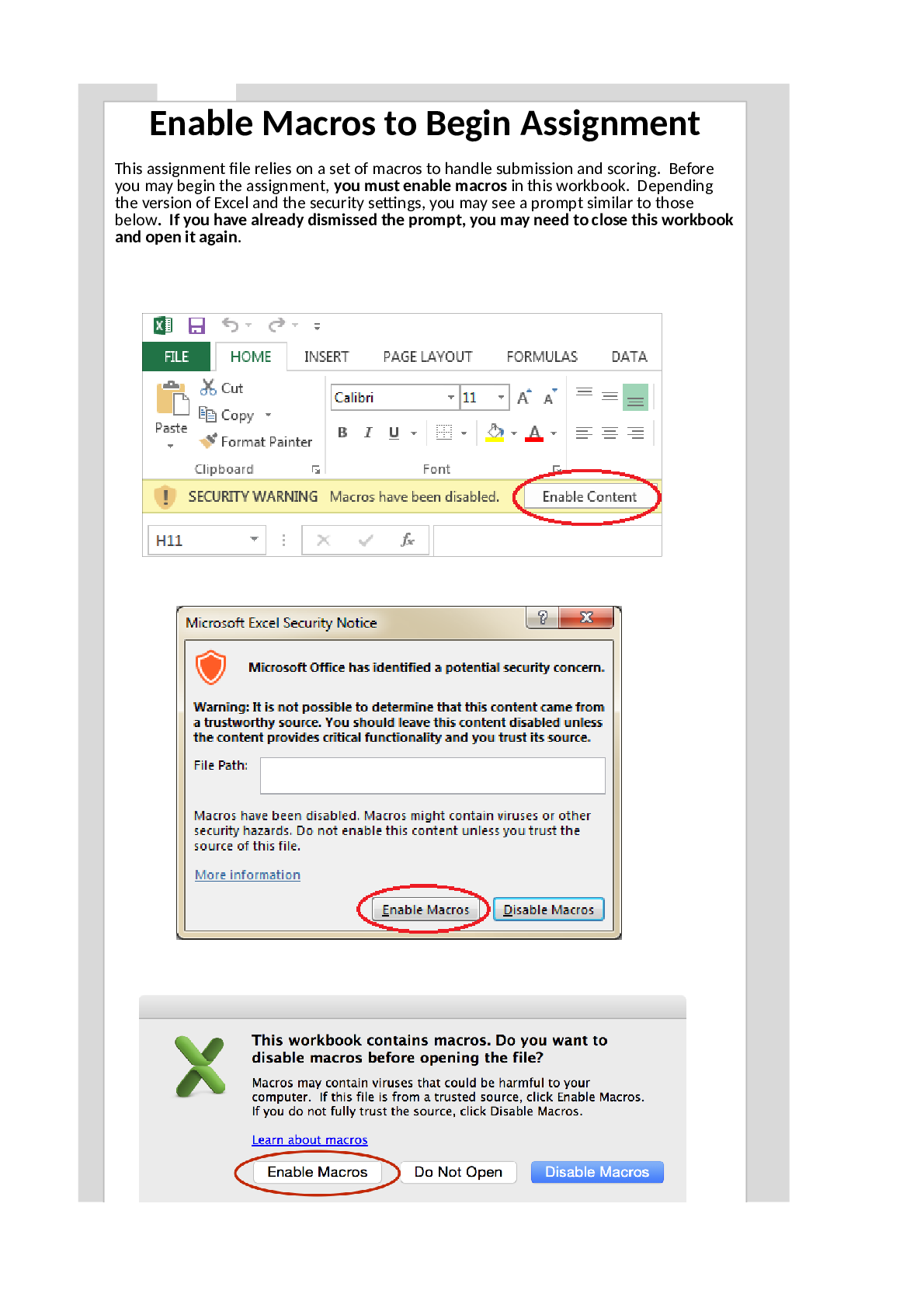
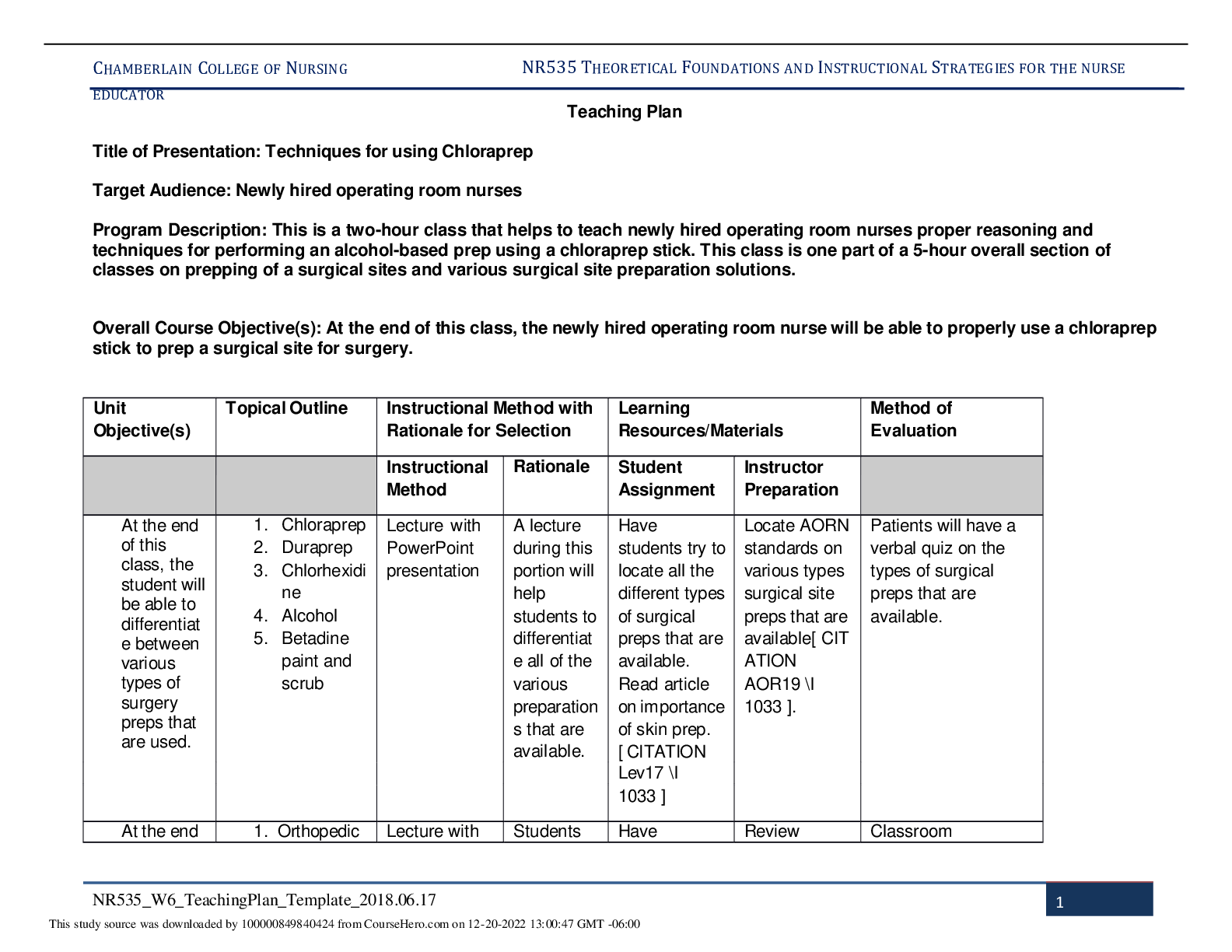
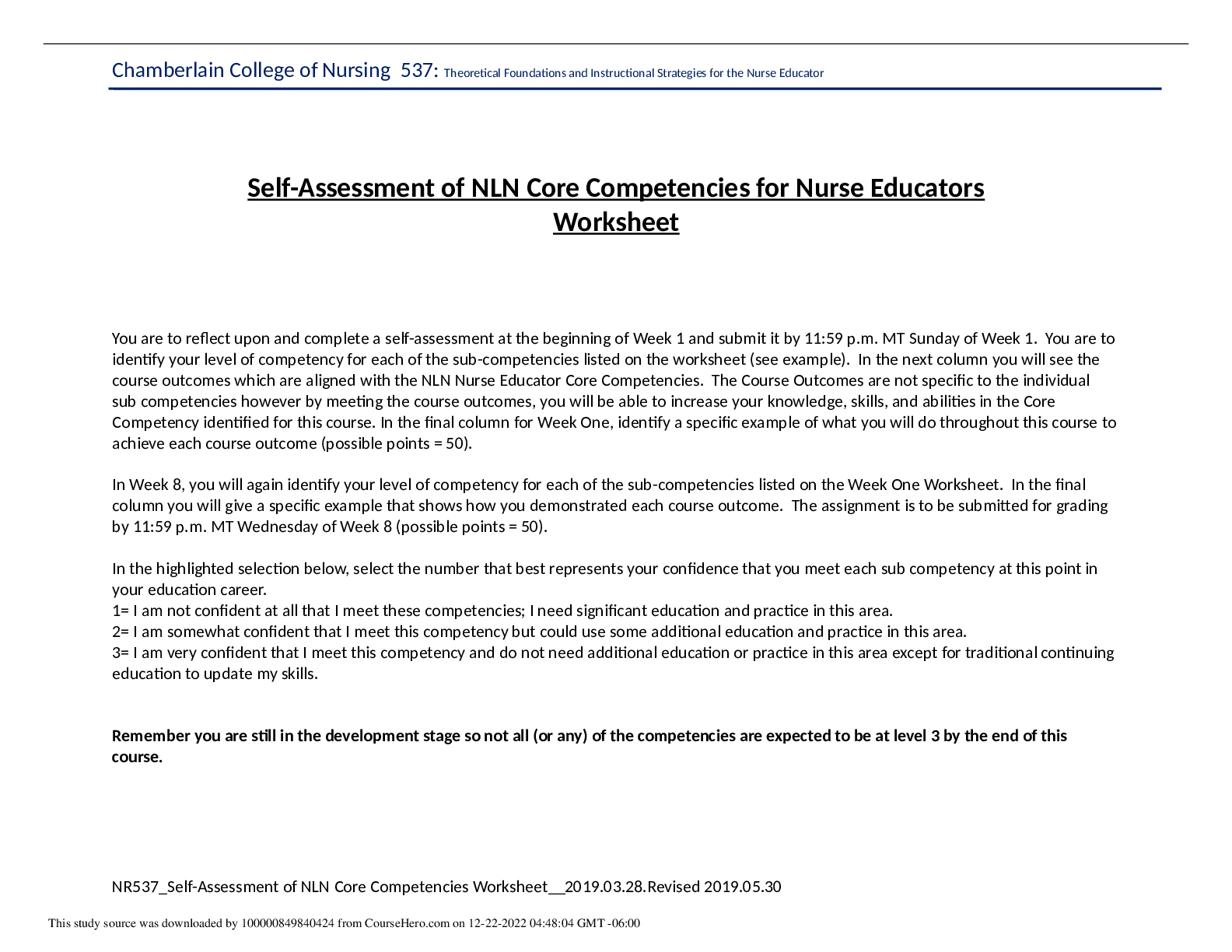
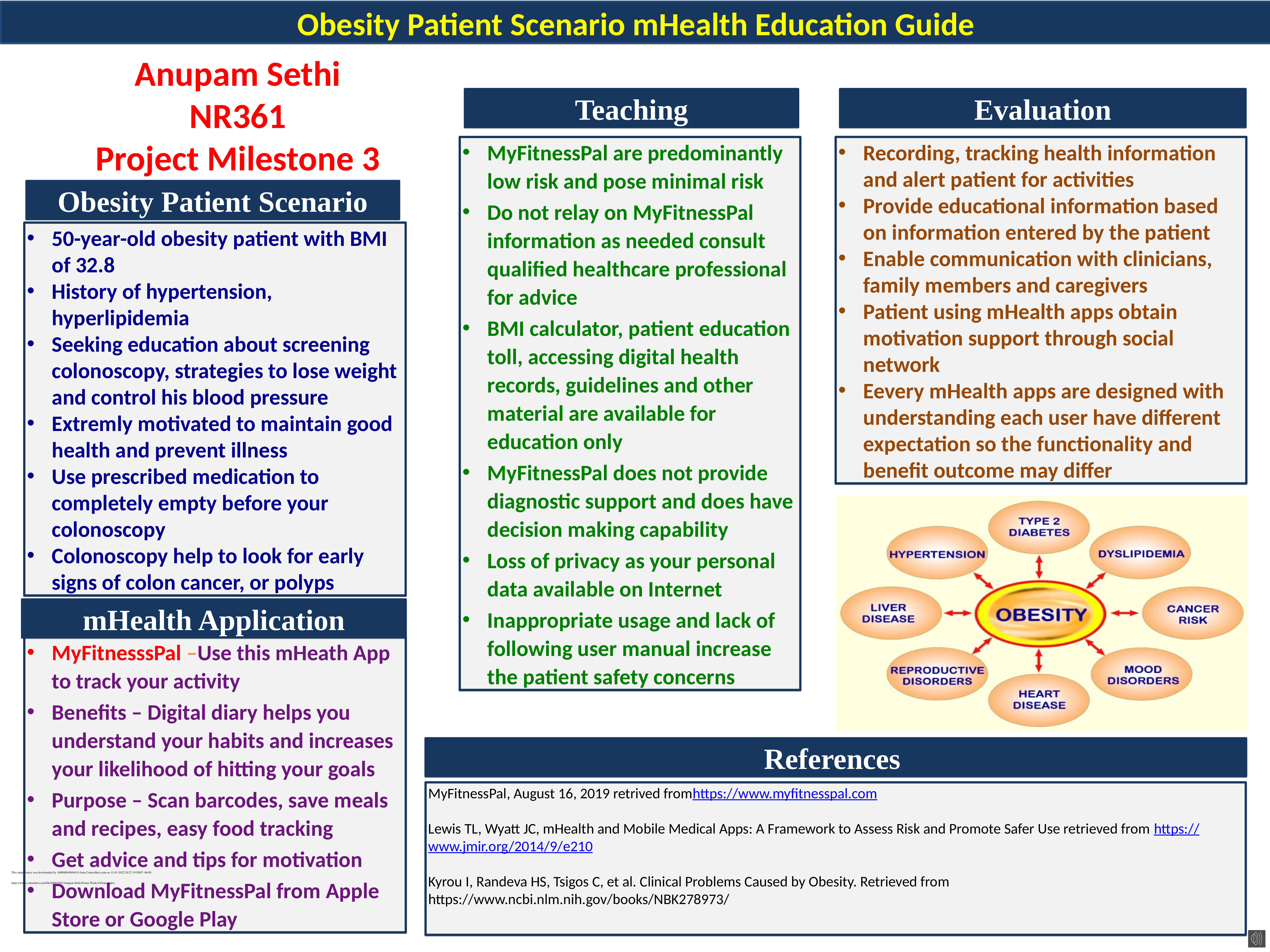

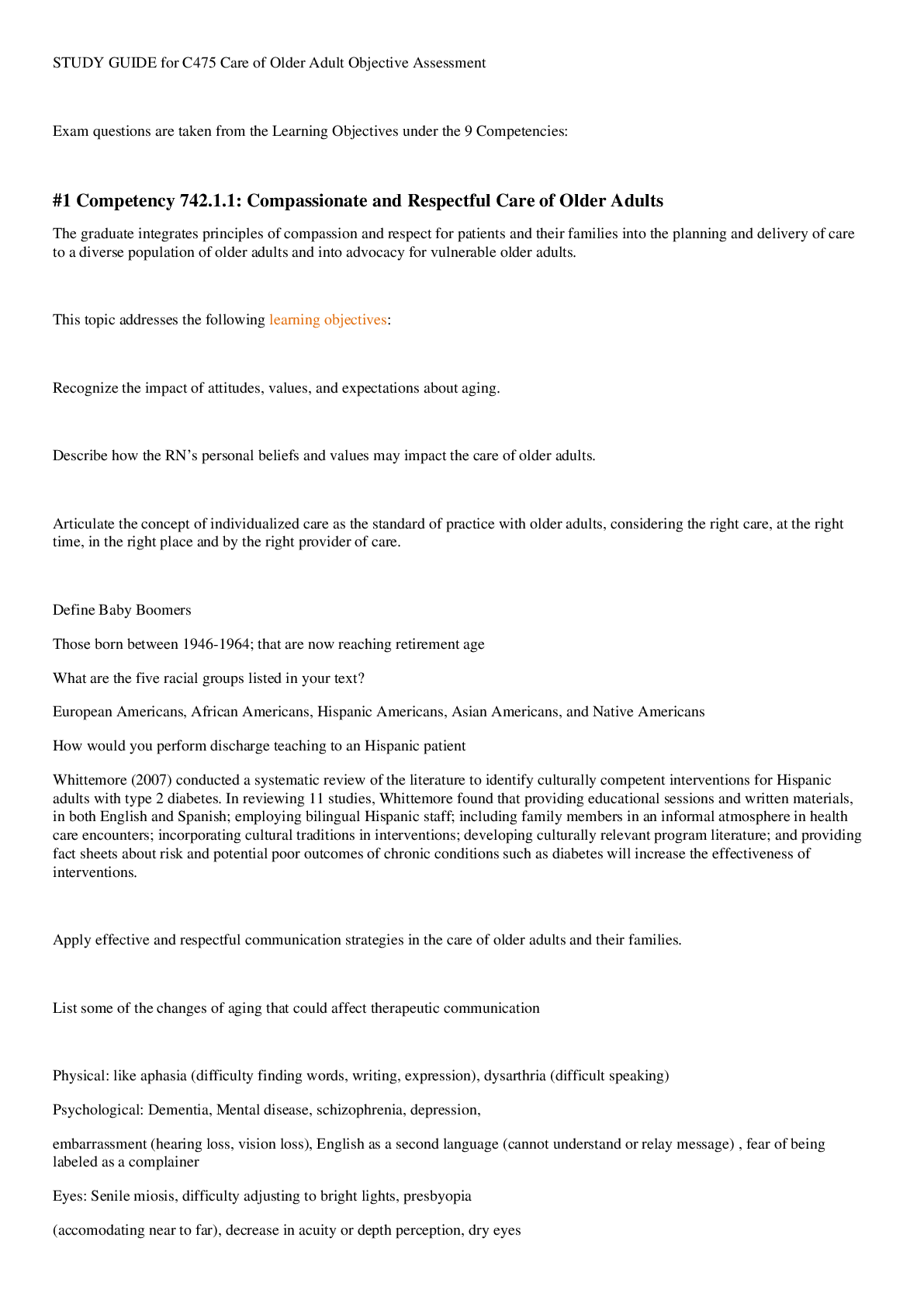
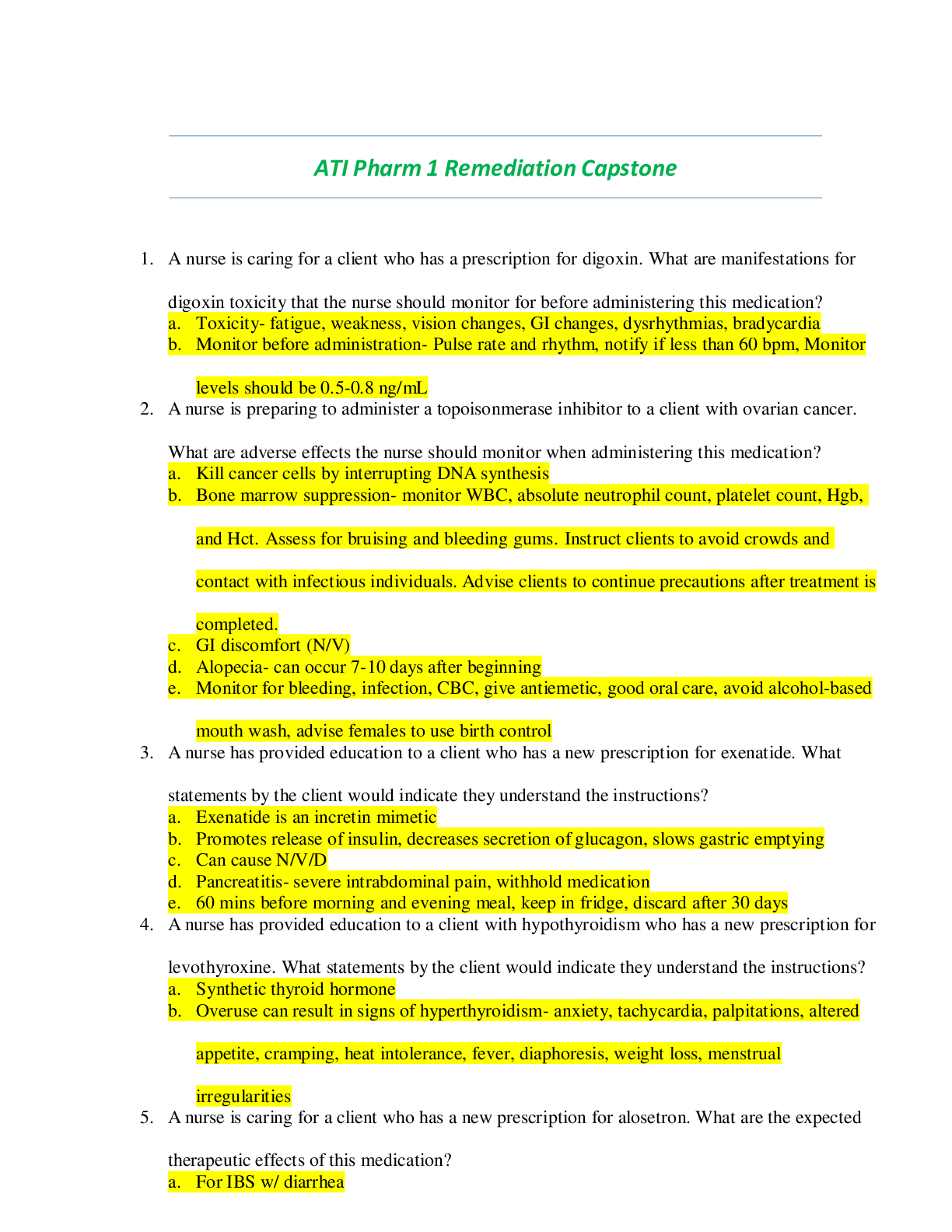
.png)

, 100% Correct, Download to Score A.png)

, 100% Correct, Download to Score A.png)

 Questions and Answers (latest Update), 100% Correct, Download to Score A.png)
 100% Correct Answers, Download to Score A.png)
 100% Correct Answers, Download to Score A.png)
 Questions and Answers (latest Update), 100% Correct, Download to Score A.png)
 Questions and Answers (latest Update), 100% Correct, Download to Score A.png)
 100% Correct Answers, Download to Score A.png)
 100% Correct Answers, Download to Score A.png)

